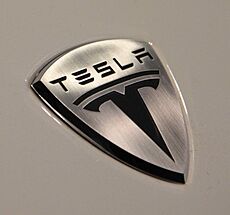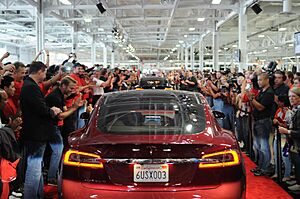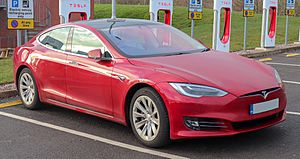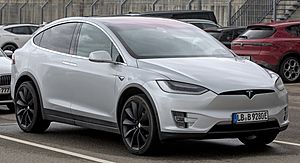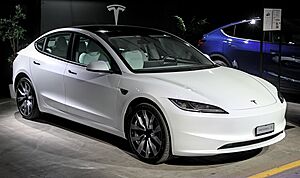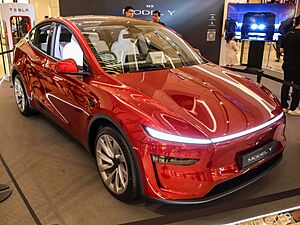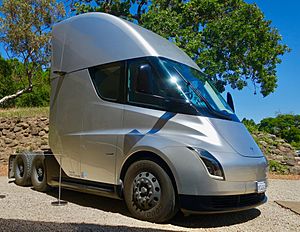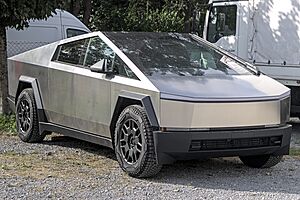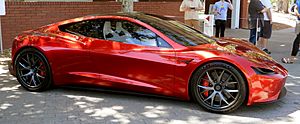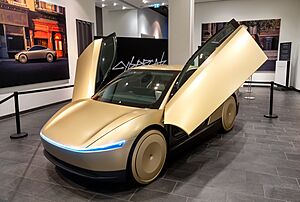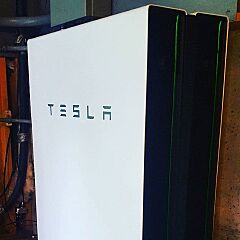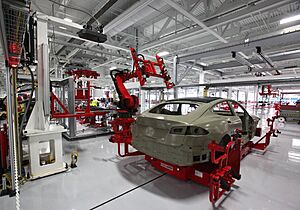Tesla, Inc. facts for kids
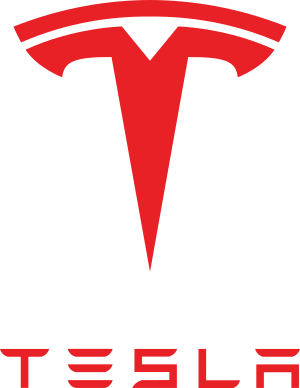 |
|||
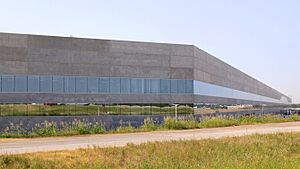
Gigafactory Texas, Tesla's main office, just outside of Austin, Texas
|
|||
|
Formerly
|
Tesla Motors, Inc. (2003–2017) | ||
|---|---|---|---|
| Public | |||
| Traded as | |||
| ISIN | ISIN: [https://isin.toolforge.org/?language=en&isin=US88160R1014 US88160R1014] | ||
| Industry |
|
||
| Founded | July 1, 2003 in San Carlos, California, U.S. | ||
| Founders | Martin Eberhard Marc Tarpenning |
||
| Headquarters |
,
U.S.
|
||
|
Number of locations
|
|
||
|
Area served
|
|
||
|
Key people
|
|||
| Products |
|
||
|
Production output
|
|
||
| Services |
|
||
| Revenue | |||
|
Operating income
|
|||
| Total assets | |||
| Total equity | |||
| Owner | Elon Musk (13%) | ||
|
Number of employees
|
|||
| Subsidiaries |
|
||
|
|||
| Footnotes / references Financials as of December 31, 2024[update]. References: |
|||
Tesla, Inc. is an American company famous for making electric cars and clean energy products. Its main office is in Austin, Texas. Tesla designs and builds electric vehicles (also called BEVs), large batteries that can store power for homes and cities, solar panels, and solar shingles that look like normal roof tiles.
The company was started in 2003 by Martin Eberhard and Marc Tarpenning. They named it Tesla to honor the inventor Nikola Tesla. Elon Musk became the company's chairman in 2004 and has been the CEO since 2008. Tesla's goal is to help the world switch from using fossil fuels to using sustainable energy.
Tesla's first car was the Roadster, a fast sports car. Since then, it has made several other models, including the Model S sedan, the Model X SUV, the more affordable Model 3 and Model Y, the Semi truck, and the futuristic Cybertruck.
Tesla is one of the most valuable car companies in the world. In 2023, its Model Y became the best-selling car in the world, which was the first time an electric car earned that title. The company has also faced some challenges, including disagreements about its workplace and criticism of its self-driving technology features.
Contents
History
How It Started (2003–2004)
Tesla Motors was founded on July 1, 2003, by Martin Eberhard and Marc Tarpenning. They wanted to create a car company that was also a technology company. They believed the most important parts of an electric car were the battery, the software, and the motor.
In 2004, the company needed money to grow. Elon Musk, who had recently made a lot of money from selling his part of PayPal, invested $6.5 million. This made him the biggest shareholder and the chairman of the board. Soon after, J. B. Straubel joined as the chief technical officer. Later, the company decided that all five men—Eberhard, Tarpenning, Musk, Straubel, and early employee Ian Wright—could be called co-founders.
The First Car: Roadster (2005–2009)
Tesla's plan was to start with a high-priced sports car to attract attention and raise money. Then, they would use that money to build more affordable cars for everyone. Their first car, the Roadster, began production in 2008.
The company faced many challenges and almost ran out of money. Elon Musk invested more of his own money to keep it going. In 2009, Tesla received a $465 million loan from the U.S. Department of Energy. This loan helped them design and build their next car, the Model S. Tesla paid back the loan with interest in 2013.
Getting Popular: Model S and Model X (2010–2015)
In 2010, Tesla bought a large car factory in Fremont, California, from Toyota. This factory, now called the Tesla Factory, is where they started building the Model S. The Model S, a luxury sedan, was launched in 2012 and won many awards. It was the best-selling electric car in the world in 2015 and 2016.
In 2014, Tesla introduced Tesla Autopilot, a driver-assistance system. In 2015, the company launched its third car, the Tesla Model X. The Model X is an SUV known for its unique "falcon-wing" doors that open upwards.
A Car for More People: Model 3 (2016–2018)
In 2016, Tesla bought SolarCity, a company that installs solar panels. This helped Tesla expand into the clean energy business. In 2017, the company changed its name from Tesla Motors to Tesla, Inc. to show it was more than just a car company.
Tesla revealed the Model 3 in 2016. It was designed to be much more affordable than the Model S and X. The car was so popular that Tesla received over 325,000 reservations in just one week. However, the company struggled to build the cars fast enough, a time Elon Musk called "production hell." By the end of 2018, they had solved the problems, and the Model 3 became the world's best-selling electric car.
Growing Around the World (2019–Present)
Tesla continued to grow quickly. In 2020, the company's value increased so much that it became the most valuable carmaker in the world. In March 2020, Tesla started delivering its newest car, the Model Y, a crossover SUV based on the Model 3.
To build more cars, Tesla opened huge new factories called Gigafactories. They opened Gigafactory Shanghai in China (2019), Gigafactory Berlin in Germany (2022), and Gigafactory Texas in the U.S. (2022). In 2021, Tesla moved its official headquarters to Texas.
In late 2023, Tesla began delivering the long-awaited Cybertruck. In 2024, the company showed off concepts for a self-driving taxi called the Cybercab and a van called the Robovan. In July 2025, Tesla opened its first showroom in India and added the AI chatbot Grok to its cars through a software update.
Tesla's Cars and Trucks
As of 2025, Tesla sells six different vehicles. The company's first car, the original Roadster, is no longer sold.
Cars You Can Buy Now
Model S
The Model S is a large, stylish sedan with a lot of room for passengers and cargo. It's known for being very fast and having a long driving range. It was the first electric car to become the top-selling car in any country.
Model X
The Model X is a mid-size SUV that can seat up to seven people. Its most famous feature is its "falcon-wing" rear doors that open up instead of out. This makes it easier to get in and out in tight parking spaces.
Model 3
The Model 3 is a smaller, more affordable sedan. It was designed to bring electric cars to more people. It quickly became the best-selling electric car in the world and was the first to sell over one million units.
Model Y
The Model Y is a popular crossover SUV that shares many parts with the Model 3. It offers more space and an optional third row of seats. In 2023, the Model Y became the best-selling car model of any kind in the world.
Tesla Semi
The Tesla Semi is a big, all-electric truck designed for hauling cargo. Tesla says it's much more powerful and cheaper to run than a regular diesel truck. The first Semi trucks were delivered to PepsiCo in late 2022.
Cybertruck
The Cybertruck is a pickup truck with a very unusual design. Its body is made of flat sheets of unpainted stainless steel, which makes it look like something from a science fiction movie. Its design has been both praised and criticized.
Future Vehicles
Roadster (Second Generation)
Tesla has announced a new version of its first car, the Roadster. The company claims it will be one of the fastest cars ever made. It is planned to have a very long range and incredible acceleration.
Cybercab and Robovan
Tesla is developing two new vehicles designed to be fully self-driving. The Cybercab is a small, two-passenger vehicle meant to be used as a robotaxi. The Robovan is a larger van that could carry up to 20 people.
Technology That Powers Tesla
Tesla is known for developing most of its technology itself, instead of buying parts from other companies.
Batteries
The battery is one of the most important parts of an electric car. Tesla's batteries are made of thousands of small, round battery cells, similar to those used in laptops. These are packed together into a large, flat battery pack that sits under the floor of the car. This design saves space and helps the car handle better by keeping its weight low.
Tesla uses different types of batteries for different cars. Some use batteries with nickel and cobalt, which are very powerful. Others use iron-based batteries, which are less expensive to make.
Software Updates
Tesla cars can receive software updates over the internet, just like a smartphone. These "over-the-air" updates can add new features, improve performance, or fix problems without the owner having to visit a service center. For example, Tesla can improve a car's range or add a new game to the touchscreen with a simple update.
Autopilot and Driving Assistance
All Tesla cars come with a driver-assistance system called Autopilot. It can help the driver with steering, accelerating, and braking on highways. Tesla also offers an upgrade called "Full Self-Driving (Supervised)," which adds more features, like helping with lane changes and parking.
It is very important to know that these systems do not make the car drive itself. The driver must always keep their hands on the steering wheel and be ready to take control at any moment.
Clean Energy Products
Besides cars, Tesla also has a division called Tesla Energy. This part of the company makes products that generate and store clean energy.
- Solar Roof and Solar Panels: Tesla makes solar panels that can be installed on a roof. They also make the Solar Roof, which is made of solar shingles that look like regular roof tiles but generate electricity from the sun.
- Powerwall: The Powerwall is a large, rechargeable battery for your home. It can store energy from solar panels during the day and power your home at night. It can also provide backup power if the electricity goes out.
- Megapack: The Megapack is a giant battery, about the size of a shipping container. These are used by utility companies to store huge amounts of energy for entire towns and cities. They help make the power grid more stable, especially when using wind and solar power.
How Tesla Sells and Services Cars
Tesla does things differently from most other car companies. Instead of selling cars through separate businesses called dealerships, Tesla sells its cars directly to customers through its own stores and website. These stores are often located in shopping malls or busy city areas.
Supercharger Network
To make long-distance travel easy, Tesla built its own network of fast-charging stations called Superchargers. These stations can add hundreds of miles of range to a car in under an hour. There are thousands of Supercharger stations all over the world. Recently, Tesla has started to allow electric cars from other brands to use its Supercharger network as well.
Vehicle Servicing
When a Tesla car needs to be repaired, the company often tries to diagnose the problem over the internet first. If the car needs hands-on work, Tesla can send a mobile technician to the owner's home or have them bring the car to a Tesla Service Center.
Vehicle Safety and Issues
Like all carmakers, Tesla has faced issues with its vehicles and has had to make improvements.
- Recalls: Sometimes, a car company finds a problem with its vehicles and needs to fix it. This is called a recall. Tesla has had several recalls. In many cases, Tesla can fix the problem with an over-the-air software update, so the owner doesn't need to take the car anywhere.
- Battery Fires: In very rare cases, the battery in an electric car can catch fire if it is badly damaged in a crash. Tesla has worked to make its batteries safer by adding strong metal shields to protect them from damage.
- Autopilot Crashes: There have been accidents where drivers were using Autopilot. Investigations have shown that in many of these cases, the driver was not paying attention to the road. This is a reminder that driver-assistance systems are helpers, not replacements for an alert driver.
- Phantom Braking: Some drivers have reported an issue where their car's automatic braking system brakes suddenly for no reason. This is known as "phantom braking." Tesla has been working on software updates to fix this problem.
Images for kids
See also
 In Spanish: Tesla, Inc. para niños
In Spanish: Tesla, Inc. para niños
- List of automobile manufacturers of the United States
- List of Easter eggs in Tesla products
- List of production battery electric vehicles
- Plug-in electric vehicles in California
- Plug-in electric vehicles in the United States


